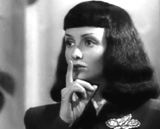
|
The Seventh Victim (1943) (aka The
7th Victim)
In director Mark Robson's (his directorial debut film)
low-budget, noirish, creepy, doom-laden, psychological horror film
and Gothic thriller (with the tagline: "SLAVE to SATAN")
- also produced by RKO's Val Lewton, known for atmospheric suspense;
the enigmatic Satanic-tinged story was a precursor to Roman Polanski's Rosemary's
Baby (1968), and even had a Psycho-like shower sequence:
- the character of naive, innocent, orphaned young
private school student Mary Gibson (Kim Hunter in her film debut),
who learned from convent nuns in her upstate NY Catholic school,
Miss Highcliff's, that her older sister Jacqueline Gibson (Jean
Brooks), the owner of La Sagesse - a successful cosmetics factory,
had been missing for a number of months (and was not paying Mary's
tuition)
- the continual search for the missing Jacqueline in
New York's Greenwich Village, where Mary located errant Jacqueline's
NYC apartment (a bare room with a chair and hangman's noose) above
Dante's, an Italian restaurant, and learned that wealthy NYC lawyer
Gregory Ward (Hugh Beaumont) who was paying the rent - was her brother-in-law
after a secret marriage to Jacqueline (although it had failed) [The
film took a strange turn when Mary and Gregory also fell in love
with each other.]
- Gregory's explanation to Mary of Jacqueline's suicidal
tendencies, with a hangman's noose waiting for her in her room: "Your
sister had a feeling about life, that it wasn't worth living unless
one could end it. I helped her get that room....that room made her
happy in some strange way I couldn't understand. She lived in a world
of her own fancy. She didn't always tell the truth. In fact, I'm
afraid she didn't know what the truth was"
- the discovery that mysterious NY physician and psychiatrist,
Dr. Louis Judd (Tom Conway), had treated Jacqueline for depression;
according to him, his pale and fragile patient had become obsessed
with death and despair (in truth, Dr. Judd knew her location and
was romancing Jacqueline on the side)
- the film's sub-plot: a conspiratorial, underground
coven of witches - a deadly cult of diabolic Satanic worshippers
called The Palladists; shockingly, Jackie had given up her business
and her soul to the possessed devil cultists; she found herself kidnapped
and in their imprisoning grip, and condemned to die if she left the
group; they wished to keep her from revealing her association with
them by encouraging her to commit suicide (as the 7th departing victim!)
by drinking poison, or by assassinating her; fearing for her life,
Jacqueline went into hiding
- about a half-hour into the film - the startling first appearance
of the missing Jacqueline (with distinctive black bangs); she knocked
on a door, and when opened stood quietly, and looked straight at
her astonished sister Mary; she placed a shussing finger to her lips,
but then after becoming fearful about something off-screen, she shut
the door and seemingly evaporated
- the Psycho-like shower scene, when Mary was
confronted by Jacqueline's partner Mrs. Esther Redi (Mary Newton),
seen only as a shadow through the shower curtain (the shadow hinted
she was wearing a hat, looking like devil horns); she warned Mary
to leave town and accused Jacqueline of being a murderess: ("If
I were you, Mary, I'd go back to school. I'd make no further attempt
to find Jacqueline....Your sister, Mary, is a murderess. She killed
Irving August, stabbed him out of fright when he discovered where
she was hiding...I had to help get rid of the body...And I warn you
Mary, go back. You don't know what you're doing, or what dreadful
things you might bring about by looking for your sister. You go back
to school")
- poet Jason Hoag (Orford Gage) who was helping Mary
find her sister, confronted the group of Satanists, with his own
view of their evil convictions:
"The devil worshippers. The lovers of evil. It's a joke. Pathetic
little joke....You're a poor, wretched group of people who have taken
the wrong turning"; Mr. Brun (Ben Bard), the leader of the Palladists,
defended his Satanist beliefs: "Wrong? Who knows what is wrong
or right? If I prefer to believe in satanic majesty and power, who
can deny me? What proof could you bring that good is superior to evil?
It's hard to put into words, but you're wrong"; Dr. Judd reminded
Brun of the words of the Lord's Prayer:
"Lead us not into temptation, but deliver us from evil"
- in the surprise ending-conclusion, Jacqueline (who
escaped a suspenseful, lethal stalking by an assassin from the cult
wielding a switchblade) briefly spoke to her neighbor after returning
to her bleak rooming house - a consumptive and terminally-ill prostitute
Mimi (Elizabeth Russell); Mimi told Jacqueline that she was tired
of being afraid and waiting for death and proposed to have one last
night of laughing and dancing ("I'm going out, and I'm going
to laugh and dance, and do all the things I used to do; then, I don't
know"); Jacqueline admitted that she would happily greet death: "I've
always wanted to die, always" before entering her own empty
apartment (# 7) where a noose was prominently hanging from the ceiling
- as Mimi (in a glittering black dress) stepped out
of her apartment for her final night, she heard a chair tip over
as she passed by Jacqueline's closed apartment door (an indication
of her off-screen death), but she reacted non-chalantly; while descending
the stairs, a voice-over delivered a quote from a well-known sonnet
written by 17th century English poet John Donne: "I run to death,
and death meets me as fast. And all my pleasures are like yesterday" -
the film's final line of dialogue
|










|











